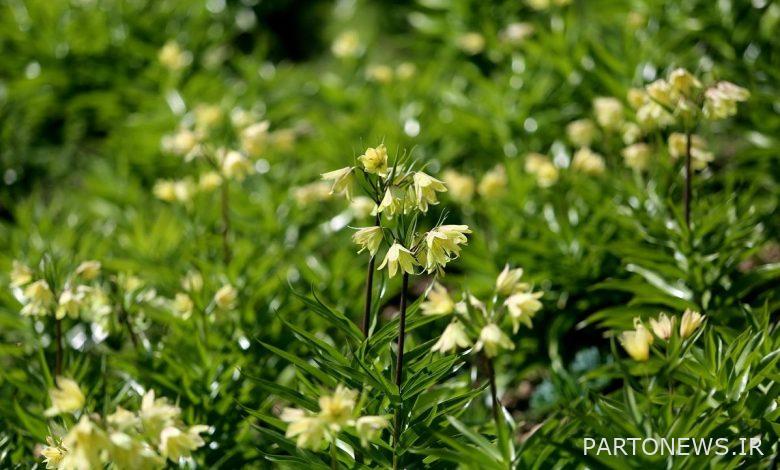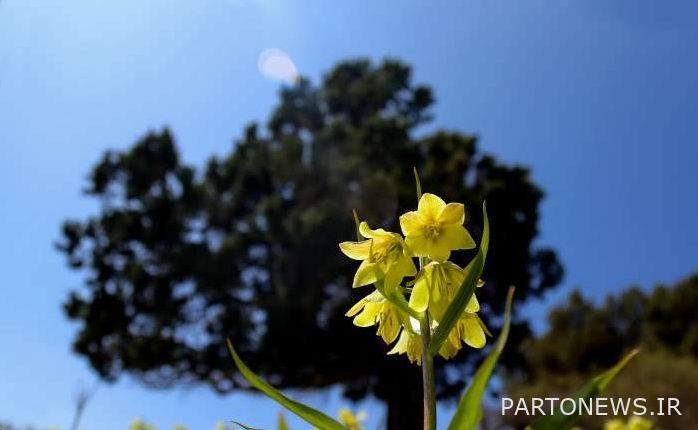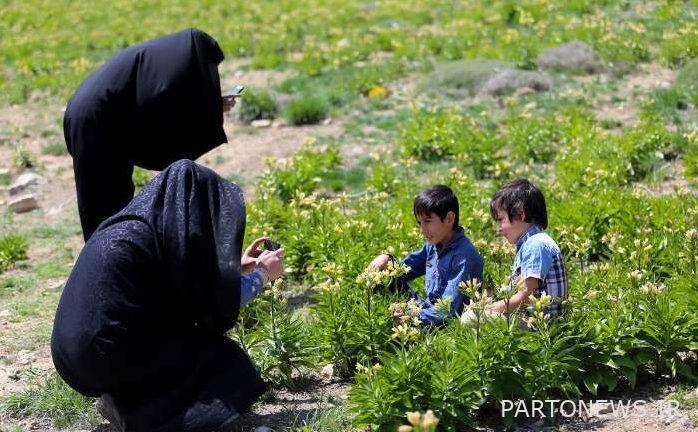Unmerciful tears over Mary’s tears

Although the four seasons of North Khorasan are beautiful, the pristine nature of the province in spring has features that may not be seen in other seasons, and the appearance of overturned tulips is one of the rarest flowers in the world in the highlands of this region of spring and Eid to nature lovers.
North Khorasan is a unique genetic repository of inverted tulips in yellow and purple that can not be seen in other parts of the country and only goes to the heights of high mountains and a picture of the handicraft of God on this region becomes beautiful.
The flowering season of this flower, which is from the order of lilies and native to the Iranian plateau, begins from mid-April to early June, and this flower because a large amount of dew collects between its petals and then falls to the ground. They also say Maryam’s tears, Qaysar’s crown and Siavash’s tears.
The life of this plant is very short and its flowering varies depending on the climate of different regions, so that it can be seen in North Khorasan from April and its flowering continues until May, and thousands of overturned tulip plants grow in the heights of North Khorasan. And it makes it unique that tourists and nature lovers can see it only once a year.
In this article you will read:
Mythical tulip
According to experts and scholars in Iranian mythological texts, special attention has been paid to the overturned tulip, and they say that when Siavash, the son of Kikavous, was killed by the Turanians, where his first drop of blood fell on the ground, Persiavash grew up and the tulip flower that witnessed this incident fell. He fell down and cried over Siavash’s innocence, after which this flower remained standing and crying and was called Laleh Vazhgon. Divine mercy and blessings are upon him.
Traces of this flower can be seen in the history of Iran. The inverted tulip or tulip is in the role of the Sassanid capitals and also in the Bostan Arch Museum next to the role of the Sassanid king.
At the same time, spring is coming and waiting for nature lovers to see this flower ends, and from mid-April to May, with the beginning of the rainy season, the best time to see this enchanting plant is Iran, and tourists and nature lovers should see this beautiful flower sooner. They should raise it because this tulip, with its short lifespan, is only a guest of Khombi soil in Garmeh and other parts of the province for a few mornings, and then it gathers its fruit and corm and will not be found anywhere until next year.

Corona and inverted tulip respiration
A tourism and environmental activist said about the location of this unique tulip: Khombi is the name of an area of approximately 10 hectares in 40 km northwest of Garmeh city, which is a valuable genetic repository of the yellow inverted tulip in North Khorasan.
Saeed Gholami added: in addition to Khombi region, the western parts of Aladagh mountain, Jozak region, Leopard and Bezdaghi mountains in Maneh and Samolghan, Bahar and Saluk mountains in Jajarm, parts of Asadli mountain in Bojnourd and Tekel Ghaz mountain in Raz and Jorglan border strip It is the habitat of this flower and every year a large number of people come to watch the habitat of overturned tulips in spring.
He said that the overturned tulips in this area is a good capacity for ecotourism: “At the same time, this area should be introduced. It is necessary to provide the necessary training to tourists to visit areas such as Khombi to prevent the destruction of the area.”
Gholami added: “Although the outbreak of Corona virus in the last two years was an unpleasant event that caused a lot of damage and blows to the tourism industry of the province, but it caused nature to breathe and an opportunity to revive the overturned tulip plain.”
He pointed out: “Unfortunately, human intervention in the area of yellow and purple overturned tulips (Maryam tears) as one of the rarest flowers in the world, in North Khorasan province was in danger of extinction and the area was declining. Now the situation has improved a little. I am expected that the authorities will take measures to preserve this area so that the area will not be destroyed again with the arrival of tourists.
Unique tulips
One of the professional nature walkers of Bojnourd also said about this unique onion plant: in many parts of the country, overturned tulips can be seen. What distinguishes the tulips of the province from other places is the yellow color of overturned tulips. It is a khombi that is very attractive to people and tourists.
Hossein Vahedi stated that the nature walkers are aware of the value of this flower and said: However, some people who have only given the name of the nature walker with irrational behaviors, digging and kicking this flower, not only the habitats of this flower They destroy the plant, but endanger the generation of this plant.
He added: “It is true that this place is enclosed and protected, but more than this, we should have been more careful and concerned about the protected areas and did not allow people who set foot in nature to destroy it.”
He said: “Some people should promote their nature tourism culture more than this, and not dig and destroy habitats such as tulip habitats in order to see the eyes of environmentalists, which is not justifiable.”
Vahedi, stating that the culture of nature tourism in this country is declining day by day, added: “Unfortunately, instead of improving their knowledge and preserving their natural and environmental resources, people seem to be alien to these issues and wherever they go.” Rejection of destruction can also be seen.
Referring to the area where this rare tulip flower grows, he said: “Khombi and Sarai in Garmeh are the habitat of this tulip, and due to the hot and dry climate of this region, the flower grows on the nature of Khombi.” It changes from mid-April to May and creates a beautiful ecotourism attraction.
He said: “It is fascinating to see tulips that have risen from the rocky ground and greet the sun again, and for this reason, areas such as Khombi and Sarai need more care in the spring.”

Tears of lovelessness
The commander of the Natural Resources Protection Unit also said: “Laleh Vazhgon or” Maryam Tears “has been registered as a national natural monument in the country due to its importance as a genetic reserve, which shows the importance and uniqueness of this genetic reserve.” It is natural and in order to preserve and revive this flower, research measures should be taken to provide the ground for growing this flower in greenhouses.
Musa Reza Hayati, referring to the decrease in the area of overturned tulips in the province, noted: This area was very large until ten years ago, but now it has reached half of the previous area.
He says that in seasons such as spring and the time of plant growth, one should be more careful in areas such as Khombi and Sarai. It should be noted that people should not be allowed to enter these areas and try to destroy the habitat of this unique tulip.
Lack of sufficient force for protection
The commander of the North Khorasan Natural Resources Protection Unit added: “The most important factor in the destruction of this flower’s habitat is the people who flock to Sarai and Khombi in Garmeh in the spring.”
Hayati stated: The habitat of this unique species is enclosed for more protection in Khombi area and Sarai Garmeh to be specially protected by the rangers, but the number of personnel of the protection unit of the General Directorate of Natural Resources is not large enough to be able to continuously And monitor and control the area around the clock.
He stated that another factor of destruction is the entry of livestock into this habitat and said: “Some people who come to the area to see the overturned tulip are not aware of its importance and their behaviors cause the destruction of this area. They have the necessary, but there is a possibility of livestock entering at night.
He added: “The authorities should also consider the protection of this area in their actions, and why it is necessary to hold a festival in this area during which people light fires and cook food, and travel inside the tulip habitat.” Have?

More protection from overturned tulips
The head of the General Department of Environmental Protection of North Khorasan also announced the possibility of adding the protected areas of Qarkhod, Khombi and Sarai in this province to the Golestan Biosphere Reserve and expressed hope that after this action, the area of overturned tulips will be more protected.
Reza Shekarian added: “We are trying to include Laleh Vazhgon and Saffron mountain habitats in Khombi and Sarai mountains in this complex, and based on this, its management plan will be planned according to the new zoning plan, in which in addition to sustainable protection In addition to biodiversity in the Golestan complex, special measures will be taken to alleviate poverty and attract the participation of local communities in the management of the Golestan Biosphere Reserve, and the reserve funds will be spent on the management of these areas.
Golestan Biosphere Reserve is a transnational region of global importance that represents the unique natural geography at the junction of Hyrcanian forests with the ecological area of Kopeh Dagh, which has long been associated with the cultural and livelihood system of the people of northern Khorasan.
The habitat of Laleh Vazhgon or Ashk Maryam, in addition to the 15-hectare area of Khombi and Sarai, the western parts of Aladagh Mountain, Jozak region, Leopard and Bezdaghi mountains in Maneh and Samolghan, Bahar and Saluk mountains in Jajarm, parts of Asadli mountain in Bojnourd and Takel Qoz mountain in The border strip is a mystery.
Inverted tulips, unlike other species of tulips and other flowers, have returned to the ground from the stem, hence its name.
The overturned tulip of North Khorasan is different from the overturned tulip of Chaharmahal and Bakhtiari, Kohkiluyeh and Boyer-Ahmad provinces in terms of height and color, and is mainly seen with two colors, pale yellow and purple.
This plant species has great resistance to cold and special adaptation to rocky and rocky slopes, and if the habitat of this flower is not destroyed by humans and animals, it has the ability to cover large areas of nature with the growth of thousands of beautiful branches.
This plant is the fourth national natural monument of Iran, which unfortunately is in danger of extinction these days due to overgrazing, destruction of habitats to create agricultural lands, improper harvesting of this plant for supply to the flower market and other factors.
Khombi and Sarai mountain ranges are the main roughnesses of Garmeh city, which is located in the south and southwest of this city.
According to the IRNA correspondent, this area, despite being enclosed, is still not safe from the attacks of unscrupulous nature lovers, so that it has been seen that in addition to dozens of flowers being pulled out of the soil, the habitat of this tulip has also been destroyed.
With the coming of spring, hundreds of types of flowers and plants adorn this province, and the scent of nature and the slopes of the mountains, where we take refuge, becomes fragrant with the aroma of flowers and medicinal plants. The area you go to becomes an amazing picture of beauty, and it is a pity that this area of the sun under the feet of the people is destroyed.
The area of natural resources of North Khorasan is 2 million 33 thousand 36 hectares, of which 1.4 million hectares are pastures, more than 183 thousand hectares are deserts and 434 thousand 550 hectares are forests.
25,000 hectares of forests in this province are Hyrcanian and the rest of Iran is Turanian, which includes Aras, maple, hawthorn and Kirko species.
Source: IRNA

